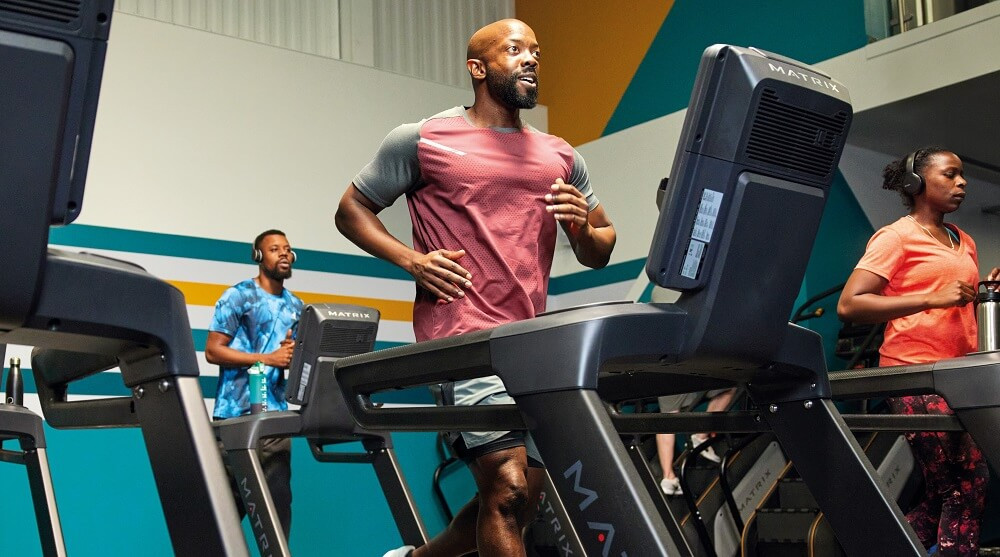Cardio fitness is a cornerstone of overall health, and when it comes to effective and accessible cardio workouts, exercise bikes and treadmills stand out as two of the most popular gym machines. Both offer fantastic ways to elevate your heart rate, burn calories, and improve endurance, yet they operate differently and provide distinct benefits.
Deciding between an exercise bike and a treadmill can be tricky. Are you aiming for weight loss, building strength, or simply enhancing your general fitness? This guide, brought to you by usabikers.net, will delve into a detailed comparison of exercise bikes and treadmills. We’ll break down the pros and cons of each, explore which machine excels for specific fitness goals like weight and fat loss and strength training, and help you determine which one is the best fit for your individual needs and preferences.
Whether you’re a seasoned athlete or just starting your fitness journey, understanding the nuances of Exercise Bike Vs Treadmill will empower you to make the right choice for a more effective and enjoyable workout experience.
Treadmill vs Exercise Bike: Unpacking the Key Differences
The fundamental difference between treadmills and exercise bikes lies in their mechanics and the workout experience they deliver.
Treadmills are designed to mimic the natural movements of walking or running outdoors. They feature a moving belt that you walk or run on, allowing you to control speed and incline to simulate various terrains and workout intensities. This weight-bearing exercise engages your body in a way that closely resembles outdoor locomotion.
Exercise bikes, on the other hand, provide a seated, low-impact workout. You pedal against adjustable resistance to simulate cycling, engaging primarily your lower body muscles with less impact on your joints. This makes them a gentler option for some individuals.
Beyond the operational differences, the impact on your body is a significant differentiator. Treadmill workouts are weight-bearing and generally higher impact, engaging more muscle groups throughout the body. Exercise bikes offer a non-weight-bearing, lower-impact alternative, which is particularly beneficial for individuals with joint pain, injuries, or those seeking a gentler form of cardio. Remember, regardless of your choice, always incorporate a proper warm-up to minimize the risk of injury.
 Exercise Bike Vs Treadmill
Exercise Bike Vs Treadmill
Exercise Bike vs Treadmill: Pros and Cons Explored
To help you further weigh the exercise bike vs treadmill decision, let’s examine the specific advantages and disadvantages of each machine.
Exercise Bike: The Pros
- Low-Impact Exercise: Exercise bikes are exceptionally gentle on the joints, making them ideal for individuals with arthritis, knee or hip problems, or those in rehabilitation. The seated position and smooth pedaling motion minimize stress on weight-bearing joints.
- Workout Versatility: From steady-state cardio for endurance building to high-intensity interval training (HIIT) for calorie burning, exercise bikes are versatile enough to accommodate a wide range of workout styles and fitness goals.
- Space-Saving Design: Typically more compact than treadmills, exercise bikes are excellent for home gyms, apartments, or smaller workout spaces. Their smaller footprint makes them easier to integrate into various home environments.
- Customizable Resistance: Adjustable resistance levels allow you to fine-tune the intensity of your workout. Whether you’re a beginner or an advanced cyclist, you can easily modify the resistance to match your fitness level and training objectives.
- Comfortable and Supportive: The seated position provides comfort and support, especially during longer workout sessions. This can be particularly beneficial for individuals who find standing for extended periods uncomfortable.
- Injury-Friendly Option: Exercise bikes offer a safe and effective way to maintain cardiovascular fitness when recovering from injuries or dealing with mobility limitations. They allow for continued exercise without exacerbating certain types of injuries.
Exercise Bike: The Cons
- Limited Upper Body Engagement: Exercise bikes primarily target the lower body muscles (legs and glutes). They offer minimal engagement of the core and upper body compared to treadmills.
- Lower Calorie Burn (Generally): Due to the reduced muscle engagement, exercise bike workouts typically burn fewer calories compared to treadmill workouts of similar duration and intensity.
- Potential for Monotony: Some users may find prolonged exercise bike sessions less engaging or more monotonous than treadmill workouts, especially if they prefer varied movement and scenery.
Treadmill: The Pros
- Weight-Bearing Benefits: Treadmill workouts are weight-bearing exercises, which are crucial for maintaining and improving bone density. This is particularly important for preventing osteoporosis and promoting long-term skeletal health. Weight-bearing activity also naturally strengthens muscles needed for daily activities.
- Workout Variety and Adjustability: Treadmills offer extensive workout variety. You can walk, jog, run, sprint, and adjust both speed and incline to create diverse and challenging workouts. This versatility keeps workouts interesting and allows for progression as fitness improves. Treadmills are excellent for walking, jogging, HIIT, and dedicated running workouts.
- Higher Calorie Expenditure: Running on a treadmill engages a larger number of muscle groups and typically at a higher intensity than cycling, leading to greater calorie burn in the same amount of time. This makes treadmills highly effective for weight loss and fat reduction.
Treadmill: The Cons
- High-Impact Nature: While treadmill running can be adjusted to be lower impact than outdoor running (by adjusting incline and speed), it remains a higher-impact exercise compared to cycling. This can pose risks for individuals with pre-existing joint issues or those prone to injuries.
- Larger Footprint and Space Needs: Treadmills generally require more space than exercise bikes. Their larger size can be a limiting factor for home gyms or individuals with limited living space.
- Increased Injury Risk (If Improperly Used): Incorrect running technique or overtraining on a treadmill can increase the risk of injuries, such as shin splints, knee pain, and ankle sprains. Proper form and gradual progression are crucial to minimize injury risk. Consulting resources on proper running technique and workout plans is advisable.
Ultimately, the optimal choice between an exercise bike vs treadmill depends heavily on your individual fitness goals, personal preferences, and any existing health considerations. Experimenting with both machines can help you determine which one aligns best with your needs and workout style.
Weight and Fat Loss: Treadmill Takes the Lead
When the primary goal is weight loss and fat reduction, treadmills generally have a slight edge over exercise bikes.
Treadmill workouts, particularly running, typically recruit more muscle mass and are performed at a higher intensity compared to cycling on an exercise bike. This greater muscle activation and intensity translate to a higher calorie burn per workout session. Running, especially at varying speeds and inclines, is a highly effective calorie-burning activity.
While exercise bikes are still excellent for burning calories and contributing to weight loss, they generally result in a slightly lower calorie expenditure compared to equivalent treadmill workouts. However, for individuals who need a lower-impact option, exercise bikes are a very viable and effective alternative for weight management. Incline treadmill workouts can also offer a lower-impact treadmill option, while still increasing calorie burn.
Strength Training: Treadmill Offers More Weight-Bearing Benefits
Both treadmills and exercise bikes contribute to overall strength improvement, but treadmills offer a slight advantage in terms of strength building, particularly for the lower body.
Treadmill running is a weight-bearing exercise. This weight-bearing aspect is critical for stimulating bone density improvement and strengthening muscles, especially in the legs, hips, and core. The act of supporting your body weight while moving engages more muscle groups and promotes functional strength development. Running is also a very specific exercise for strengthening running-related muscles, beneficial for runners training for events or improving performance.
While exercise bikes do build lower body muscle strength, the non-weight-bearing nature means they don’t provide the same bone density benefits or the same degree of functional strength development as treadmill workouts.
General Fitness: Both are Excellent Choices
For improving general cardiovascular fitness and overall health, both treadmills and exercise bikes are highly effective. The choice ultimately boils down to personal preference and individual needs, particularly concerning joint health and workout style.
Treadmill for General Fitness:
- High-Intensity Cardio: Treadmill running provides a robust cardiovascular workout that effectively strengthens the heart, improves lung capacity, and boosts overall endurance.
- Versatile Workout Options: Treadmills are incredibly versatile, allowing for adjustments in speed and incline to cater to diverse fitness levels and training goals. From gentle walking to intense sprints, treadmills can accommodate a wide spectrum of workout intensities.
- Adaptable to Fitness Levels: While generally higher impact, treadmill workouts can be modified to suit various fitness levels and preferences. Walking, brisk walking, and incline walking are lower-impact options suitable for beginners or those seeking less intense workouts.
Exercise Bike for General Fitness:
- Low-Impact Cardio Health: Exercise bikes provide a superb low-impact cardiovascular workout, making them an ideal choice for individuals with joint concerns or those recovering from injuries. They effectively elevate heart rate and improve cardiovascular health without stressing joints.
- Adjustable Intensity for All Levels: The adjustable resistance on exercise bikes allows users to customize workout intensity to match their fitness level, making them suitable for beginners to advanced athletes. Resistance adjustments create challenging and effective cardiovascular workouts.
- Comfort and Accessibility: Exercise bikes offer a comfortable and accessible exercise option for a broad range of fitness levels. The seated position is less demanding and can be more comfortable for some individuals, promoting longer and more consistent workouts.
HIIT Workouts: Maximize Intensity on Both Machines
Absolutely! High-Intensity Interval Training (HIIT) is highly effective and can be seamlessly integrated into both exercise bike and treadmill workouts. HIIT involves short bursts of intense exercise followed by brief recovery periods, maximizing calorie burn and improving cardiovascular fitness efficiently.
Here are sample HIIT routines for both machines:
HIIT Treadmill Workout:
- Warm-up: 5 minutes of brisk walking or light jogging to prepare your muscles.
- Intervals: Alternate between 1 minute of sprinting at a high speed and 1 minute of recovery by walking or slow jogging. Repeat this cycle for 15-20 minutes.
- Cool-down: 5 minutes of walking to gradually lower your heart rate.
HIIT Exercise Bike Workout:
- Warm-up: 5 minutes of easy pedaling to get your blood flowing.
- Intervals: Alternate between 30 seconds of maximum effort pedaling at high resistance and 1 minute of moderate pedaling at lower resistance. Repeat this cycle for 15-20 minutes.
- Cool-down: 5 minutes of easy pedaling to reduce heart rate and prevent dizziness.
For more HIIT workout inspiration, explore resources dedicated to HIIT cycling and treadmill routines online.
In conclusion, both exercise bikes and treadmills are invaluable tools for enhancing your fitness journey. Whether your aim is weight loss, strength gains, or improved stamina, both machines offer significant and unique benefits. If you remain unsure about the best choice for your specific goals, consulting with a fitness professional can provide personalized guidance. You can also explore further information on running exercises and cycling exercises to deepen your understanding and optimize your workouts.
Ready to start your cardio journey? Find an exercise bike or treadmill at your nearest gym and take the first step towards a healthier you!

